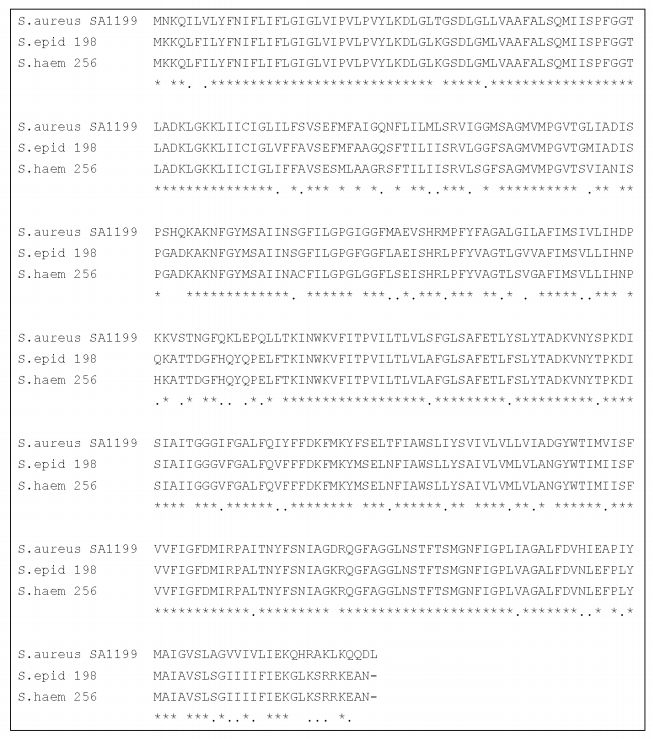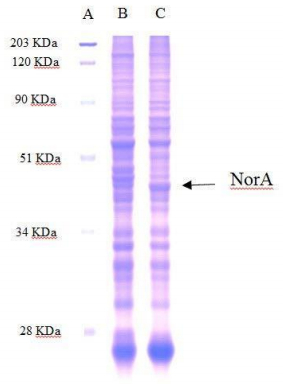Abbreviations:
| FQ |
fluoroquinolones; |
| FQR |
fluoroquinolones resistance; |
| CoNS |
coagulase-negative staphylococci; |
| MIC |
minimal inhibitory concentration; |
| EUCAST |
European Committee of Antimicrobial Susceptibility Testing |
1. Introduction
Efflux-mediated fluoroquinolone resistance has been described in Gram-positive species [1]. In Staphylococcus
aureus, Streptococcus pneumoniae, viridans streptococci, enterococci, and Bacillus subtilis FQ exporting systems belong to the MSF family, the best characterized being NorA of S. aureus and Bmr/Blt of B. subtilis, responsible for resistance to FQ, basic dyes, puromycin, chloramphenicol, and tetraphenylphosphonium [2,3].
The most information about the efflux-mediated mechanisms of FQR in staphylococci is available for S. aureus. The norA gene is expressed weakly in wild-type S. aureus cells, and norA-mediated resistance probably depends upon mutational upregulation of the gene expression, concomitant increase in production of the norA efflux pump [4,5] and target site mutations.
Less is known about Staphylococcus epidermidis and other coagulase-negative staphylococci (CoNS). Target site mutations have been described [6]. Active efflux, as suggested by blocking by reserpine, contributes substantially to the resistance phenotype in some strains of CoNS [7,8], and role of efflux overexpression of a mutation in an untraslated sequence before norA-like gene [9].
The present study was undertaken to investigate the role in intrinsic fluoroquinolones resistance of homologues of norA MFS-type efflux transporter in CoNS, namely S. epidermidis and S. haemolyticus. For this purpose, the norA-like gene was first sequenced, insert in a plasmid and then cloned in E. coli DH5α and finally the cloned gene was destroyed by transposon mutagenesis.
2. Materials and Method
The presence of norA-like sequences was investigated in CoNS strains from our collection (S. epidermidis 198, Staphylococcus capitis 92, Staphylococcus chonii 147, Staphylococcus haemolyticus 256) using PCR and degenerate oligonucleotide primers based on the highly-conserved motif of MSF-type efflux pumps (norA deg1: 5'-AATGTTTCAAAWGCAGAT-3'; norA deg2: 5'-KTTGCWGGWRCATTAGGT-3', W = A, T; K= G, T; R = A, G). PCR was performed in 0.2 ml tubes in an MJ Research (BioRad, Hercules, CA). Standard PCR reactions were carried out in 50 μl with the following final concentrations: 50 mM KCl, l0 mM Tris-HCl (pH 9.0 at 25 ℃), 0.1% Triton X-I00, 1.5 mM MgC12, 100 μM each of dNTP, 0.5 μM of each primer, 0.5 U AmplTaqGold DNA polymerase (Applied Biosystems, Foster City, CA). Standard amounts of DNA were added: 30 ng genomic DNA or plasmid DNA. PCR cycling conditions were as follows: an initial denaturation at 94 ℃ for 5 min followed by 5 cycles of 94 ℃ for 30 sec, annealing at 37 ℃ and extension at 72 ℃ for 60 sec. This was followed by 30 cycles consisting of 94 ℃ for 30 sec, 50 ℃ for 30 sec and 72 ℃ for 60 sec and a final 5-min extension step at 72 ℃.
Transposon mutagenesis, performed with EZ:TN transposon system (Epicentre, Biotechnologies, Madison, WI) was used to obtain a norASEP mutant in accordance with the manufacturer's instructions. The entire norA-like gene of S. epidermidis (norASEP) was amplified using primers derived from the gene sequence (norASEP fw 5'-CATAACCACGCACTACTTTCT-3'; norASEP rev 5'-GACACAGAATTCGTCTTGAAC-3') and cloned in the pBluescript SK plasmid (Stratagene, La Jolla, CA), resulting in plasmid pB SK 198 norASEP Transposon insertion into norASEP was done by incubating the plasmid containing norASEP with an equal molar amount of the EZ:TN < CAT > transposon, encoding chloramphenicol resistance, and EZ:TN transposase for 2 h at 37 ℃ according to the manufacturer's instructions. Following transformation of chemically competent E. coli DH5α cells (Stratagene, La Jolla, CA) with in-vitro insertion reaction, clones were selected by growth on 10 µg/ml chloramphenicol agar plates. Chloramphenicol-resistant clones were submitted to PCR analysis with norASEP primers.
The MIC of ciprofloxacin for both E. coli DH5α and S. epidermidis 198 were determined in triplicate with E-test strips according to the EUCAST guidelines [10].
SDS-polyacrylamide gel electrophoresis of NorA of E coli DH5α wild-type and harboring the recombinant plasmid. pB SK 198 norASEP was done. E. coli strains were grown in LB broth (5 ml) with ampicillin (100 µg/ml) at 37 ℃ with shaking (300 rpm). At the absorbance of 600 nm, cells were harvested and resuspended in a 0.1 volume of loading buffer and incubated for 2 min at 100 ℃.
3. Results
An amplification product of 190 bp from total DNA both of S. aureus SA 1199 (kindly provided by G. W. Kaatz), and of different species of the CoNS were obtained.
S. epidermidis 198 was selected for subsequent cloning experiments. The 190 bp PCR product was sequenced by the Taq dye-deoxy terminator method with a 377 DNA Sequencing System (Applied Biosystems, Foster City, CA). Sequence analysis and alignments were done using the Genebase version 1 computer software (Applied Maths, Kortrijk, Belgium) and revealed a high degree of homology with the corresponding sequence of S. aureus norA.
To perform the complete sequence of the norA-like gene an inverse PCR approach [11] starting from the 190 bp sequence found in the S. epidermidis 198 chromosome was followed. The norA-like gene was found to be located in a 1.7-kb fragment whose nucleotide sequence showed one open reading frame (nucleotides 568 to 1728) long enough to encode a polypeptide of 387 amino acids (accession number AJ621598). Putative promoter sequences were found at nucleotides 450 to 455 (TACAAT) and nucleotides 426 to 431 (TTGTCA), which well match the consensus sequences (TATAAT and TTGACA) for the –10 and –35 regions of E. coli promoters. An inverted repeat, which might act as a transcription terminator, was found at nucleotides 1797 to 1834. The gene was 1161 bp nucleotides in length and consisted of 387 amino acids. The sequence revealed a nucleotide identity of 75.3% with norA of S.
aureus 1199. The complete norA gene of S. epidermidis 198 was designated as norASEP. Using a similar strategy, the sequence of the norA-like gene of S. haemolyticus 256 (norASHAE) was also performed (accession number AJ621601).
Figure 1 shows the alignments between the deduced amino-acid sequence of S. aureus NorA protein and that of NorASEP and NorASHAE. The nucleotide identity of norASEP and norASHAE with norA was 75.3 and 74.1% and the amino-acid identity 87.7 and 86%, respectively. These results indicate a high degree of homology between the norA genes of CoNS and the norA gene of S. aureus.
The insertional mutagenesis approach to inactivate the norA gene was used to determine the physiological function of the protein encoded by norASEP.
Several mutants of S. epidermidis were obtained by in-vitro transposition technics [12]. The entire norASEP gene was amplified using primers derived from the gene sequence and cloned in the pBluescript SK plasmid (Stratagene, La Jolla, CA), resulting in plasmid pB SK 198 norASEP. Transposon insertion into norASEP was done with the EZ:TN < CAT > transposon and clones in chemically competent E. coli DH5α cells (Stratagene, La Jolla, CA) with in-vitro insertion reaction were selected by growth on 10 µg/ml chloramphenicol agar plates. Chloramphenycol-resistant clones were submitted to PCR analysis with norASEP primers. Insertion of the transposon in norASEP increased the amplicon length from 1.6 kb (norASEP gene without the transposon insertion) to 2.4 kb. Several clones were obtained which gave amplicons of the expected length. From one of these clones (E. coli DH5α 198 norASEP) the recombinant plasmid containing the norASEP::cat fragment (pB SK 198 norASEP EZ cat) was purified and sequenced.
In Table 1 are reported the results of MICs of some fluoroquinolones that are NorA efflux substrate as ciprofloxacin, levofloxacin and ofloxacin. MICs are measured also for substrate as the moxifloxacin that effect NorB but NorA efflux pumps. All antibiotics were tested alone and in presence of carbonyl m-chlorophenylhydrazone (CCCp) an efflux pumps inhibitor. E. coli DH5α carrying the plasmid pB SK 198 norASEP had a ciprofloxacin MIC of 0.25 μg/ml, eight times higher than the MIC of E. coli DH5α carrying the plasmid pB SK 198 norASEP EZ cat norASEP (MIC = 0.032 μg/ml) and E. coli DH5α without plasmid. Similar effect is register for levofloxacin and ofloxacin. There are no effects indeed in the MICs of moxifloxacin as well the tetracycline, since they are not substrates of NorA pump.
Table 1. MICs value of E coli DH5α and its trans-conjugants for fluoroquinolones and tetracycline, in absence and presence of CCCp.
| Strains |
MIC (mg/L) |
|
Ciprofloxacin |
Levofloxacin |
Ofloxacin |
Moxifloxacin |
Tetracycline |
|
–CCCp |
+CCCpa |
–CCCp |
+CCCpa |
–CCCp |
+CCCpa |
–CCCp |
+CCCpa |
–CCCp |
++CCCpa |
| E. coli DH5α |
0.032 |
0.032 |
0.015 |
0.015 |
0.015 |
0.015 |
0.0075 |
0.0075 |
0.5 |
0.5 |
| E. coli DH5α pB SK 198 norASEP |
0.25 |
0.015 |
0.12 |
0.015 |
0.06 |
0.015 |
0.015 |
0.015 |
1 |
1 |
| E. coli DH5α pB SK 198 norASEP EZ cat |
0.032 |
0.032 |
0.015 |
0.015 |
0.015 |
0.015 |
0.015 |
0.015 |
0.5 |
0.5 |
| a Carbonyl m-chlorophenylhydrazone (CCCp) was added with concentration of 1 µg/ml. |
In order to confirm expression of the efflux pump protein we performed a SDS-polyacrylamide gel electrophoresis (PAGE) and NorA expression analysis in E coli DH5α wild-type and harboring the recombinant plasmid pB SK 198 norASEP. In Figure 2 we showed the presence of aroung 42 KDa protein in the strains harboring the recombinant plasmid only.
4. Conclusion
Our results demonstrated that norA-like genes play an important role in the intrinsic FQR in CoNS. The resistance level to FQ due to NorA efflux pumps is not elevated. Like in other species such as S. aureus, S. pneumoniae the overexpression of efflux pumps combined with other mechanisms may contribute to increase the resistance at high level.
Acknowledgments
We thank G.W. Kaatz for the kind gift of S. aureus SA 1199.
Conflict of Interest
All authors declare no conflicts of interest in this paper.










 DownLoad:
DownLoad: 





